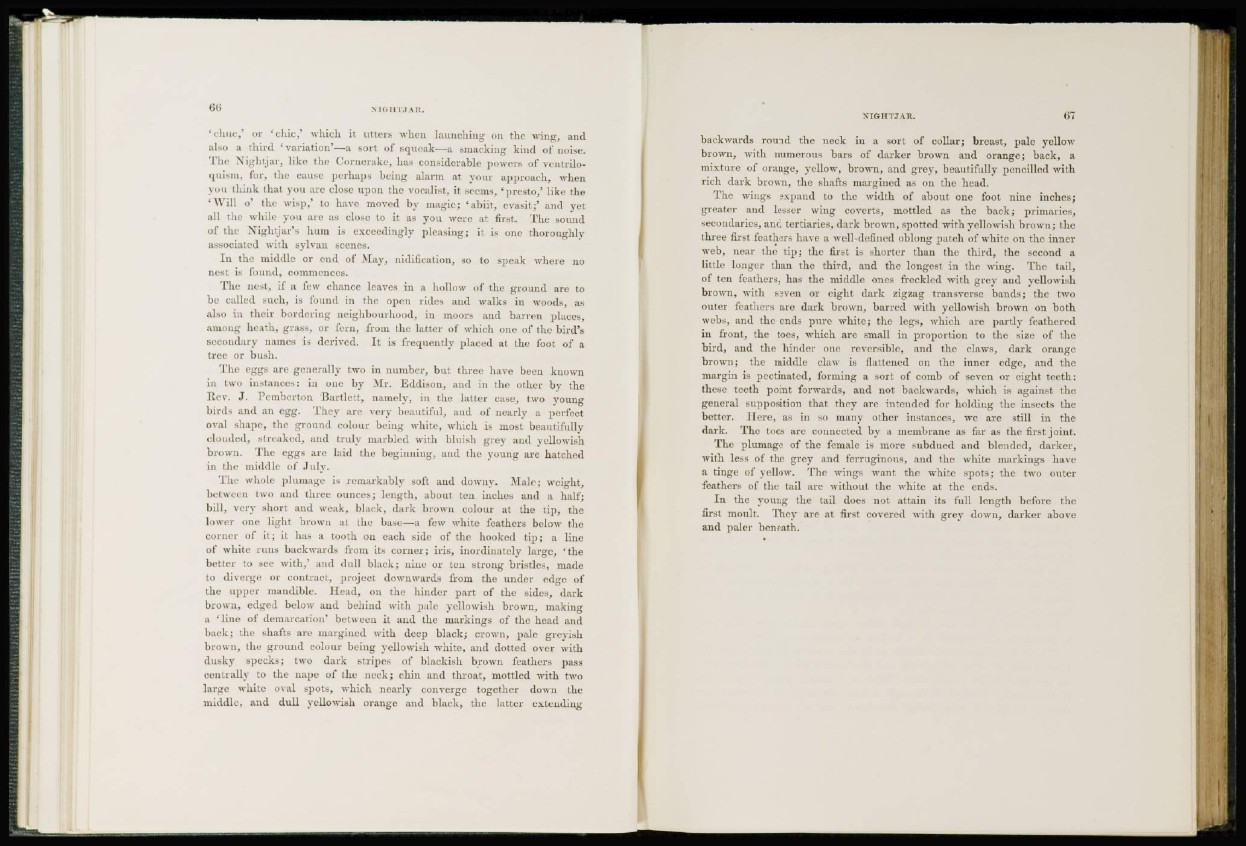
'[•hue,'' or 'chic,' which it utter.-- when launching on the wing, and
also a third ' variation*—a sort of squeak—a smacking kind of noise.
The Nightjar, like the Corncrake, lias considerable powers of ventriloquism,
for, the cause perhaps being alarm at your approach, when
you think that you arc close upon the vocalist, it seems, 'presto,' like the
'Will o' the wisp,' to have moved by magic; ' abiit, evasit;' and yet
all the while you are as close to it as you were at first. The sound
of the Nightjar's hum is exceedingly pleasing; it is one thoroughly
associated with sylvan scenes.
In the middle or end of May, nidification, so to speak where no
nest is found, commences.
The nest, if a few chance leaves in a hollow of the ground are to
be called such, is found in the open rides and walks in woods, as
also in their bordering neighbourhood, in moors and barren places,
among heath, grass, or fern, from the latter of which one of the bird's
secondary names is derived. It is frequently placed at the foot of a
tree or bush.
The eggs are generally two in number, but three have been known
in two instances: in one by Mr. Eddlson, and in the other by the
Rev. J. Pemberton Bartlett, namely, in the latter case, two young
birds and an egg. They are very beautiful, and of nearly a perfect
oval shape, the ground colour being white, which is most beautifully
clouded, streaked, and truly marbled with bluish grey and yellowish
brown. The eggs are laid the beginning, and the young are hatched
in the middle of July.
The whole plumage is remarkably soft and downy. Male; weight,
between two and three ounces; length, about ten inches and a half;
bill, very short and weak, black, dark brown colour at the tip, the
lower one light brown at the base—a few white feathers below the
corner of it; it has a tooth on each side of the hooked tip; a line
of white runs backwards from its corner; iris, inordinately large, 'the
better to see with,' and dull black; nine or ten strong bristles, made
to diverge or contract, project downwards from the under edge of
the upper mandible. Head, on the hinder part of the sides, dark
brown, edged below and behind with pale yellowish brown, making
a 'line of demarcation' between it and the markings of the head and
back; the shafts are margined with deep black; crown, pale greyish
brown, the ground colour being yellowish white, and dotted over with
dusky specks; two dark stripes of blackish brown feathers pass
centrally to the nape of the neck; chin and throat, mottled with two
large white oval spots, which nearly converge together down the
middle, and dull yellowish orange and black, the latter extending
N I G H T J A R .
backwards round the neck in a sort of collar; breast, pale yellow
brown, with numerous bars of darker brown and orange; back, a
mixture of orange, yellow, brown, and grey, beautifully pencilled with
rich dark brown, the shafts margined as on the head.
The wings expand to the width of about one foot nine inches;
greater and lesser wing coverts, mottled as the back; primaries,
secondaries, and tertiaries, dark brown, spotted with yellowish brown; the
three first feathers have a well-defined oblong patch of white on the inner
web, near the tip; the first is shorter than the third, the second a
little longer than the third, and the longest in the wing. The tail,
of ten feathers, has the middle ones freckled with grey and yellowish
brown, with seven or eight dark zigzag transverse bands; the two
outer feathers are dark brown, barred with yellowish brown on both
webs, and the ends pure white; the legs, which are partly feathered
in front, the toes, which are small in proportion to the size of the
bird, and the hinder one reversible, and the claws, dark orange
brown; the middle claw is flattened on the inner edge, and the
margin is pectinated, forming a sort of comb of seven or eight teeth:
these teeth point forwards, and not backwards, which is against the
general supposition that thev are intended for holding the insects the
better. Here, as in so many other instances, we are still in the
dark. The toes arc connected by a membrane as far as the first joint.
The plumage of the female is more subdued and blended, darker,
with less of the grey and ferruginous, and the white markings have
a tinge of yellow. The wings want the white spots; the two outer
feathers of the tail are without the white at the ends.
In the young the tail does not attain its full length before the
first moult. Thev are at first covered with grev down, darker above
and paler beneath.